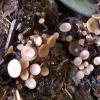
27-11-2025 15:41
Thomas LæssøeSpores brownish, typically 4-celled; 26.8 x 2.4;

27-11-2025 12:01
Thomas Læssøehttps://svampe.databasen.org/observations/10496727

27-11-2025 11:46
Thomas Læssøehttps://svampe.databasen.org/observations/10493918

27-11-2025 11:31
Thomas LæssøeCollectors notes: Immersed ascomata, erumpent thro

23-09-2025 13:31
Thomas Læssøehttps://svampe.databasen.org/observations/10534623

25-11-2025 14:24
Thomas Læssøehttps://svampe.databasen.org/observations/10490522

26-11-2025 18:13
The entire run of Mycotaxon is now available throu

25-11-2025 11:03
Mick PeerdemanHi all,One of my earliest microscopy attempts, so
Ciboria americana?
Raúl Tena Lahoz,
16-09-2010 11:15
 Hi again!
Hi again!Yesterday I found this Ciboria on a Quercus pyrenaica stromatized fruit. A stromatized area can be found at the base of the apothecia. Because Ciboria batschiana has always two nucleus?, it cannot be my species. I see that there is other species on the same host: Ciboria americana. So my question is if mine can be Ciboria americana.
Spores with one nucleus: 9-12 x 4-5 µm, nearly no oil drops, with spore sheath.
Paraphyses with one large refractive VB in the upper segment, width up to 4-5,5 µm.
Subhymenium slightly brown-pigmented, reactng light blue in IKI and enhanced in IKI after KOH.
Medulla: more or less hyaline textura intricata parallel to hymenium, also a bit reacting light blue in IKI but only noticed after KOH.
Asci: up to 95 x 9,5 µm, arising from croziers, euamyloid, Sclerotinia-type.
Ectal excipulum composed by pigmented (brown-reddish) rounded cells which protrude at margin and in outermost cells. Some bear VBs. No reaction in IKI, even after KOH.
I think there is enough data in the PDF file, but I have more photos if you need.
Thanks in advance,
Raúl.
Hans-Otto Baral,
16-09-2010 12:56

Re:Ciboria americana?
Yes, C. americana has binucleate spores in my experience, also usually rather long apo-stipes. I think it is C. americana.
The VBs coagulate when the cells die, yes, later they might get brownish by oxidation.
Your "dead" paraphyses are eprhaps only young ones without VBs. Look vacuolated.
Zotto
The VBs coagulate when the cells die, yes, later they might get brownish by oxidation.
Your "dead" paraphyses are eprhaps only young ones without VBs. Look vacuolated.
Zotto
Nicolas VAN VOOREN,
16-09-2010 13:13
Raúl Tena Lahoz,
16-09-2010 14:54

Re:Ciboria americana?
Thanks Zotto
I guess that where you say: "Yes, C. americana has binucleate spores in my experience, also usually rather long apo-stipes.", you wanted to say: "Yes, C. batschiana has binucleate spores in my experience, also usually rather long apo-stipes."
Mine are not binucleate.
Also, Ciboria americana has long stipe?
Merci Nicolas
Spores where binucleate in your collection?
Raúl
I guess that where you say: "Yes, C. americana has binucleate spores in my experience, also usually rather long apo-stipes.", you wanted to say: "Yes, C. batschiana has binucleate spores in my experience, also usually rather long apo-stipes."
Mine are not binucleate.
Also, Ciboria americana has long stipe?
Merci Nicolas
Spores where binucleate in your collection?
Raúl
Hans-Otto Baral,
16-09-2010 21:10

Re:Ciboria americana?
you are right, Raul, and I will not change that, otherwise your answer becomes weird. :-)
Obviously there are also long stipes possible. Have you a microphoto or drawing, Nicolas?
Zotto
Obviously there are also long stipes possible. Have you a microphoto or drawing, Nicolas?
Zotto
 12878.pdf
12878.pdf
